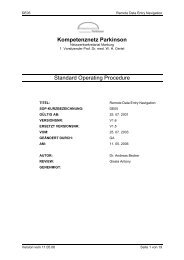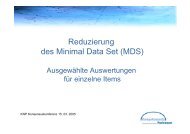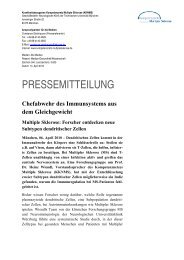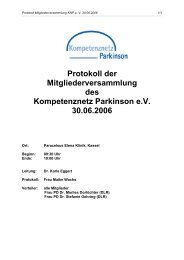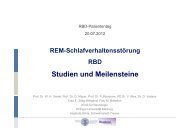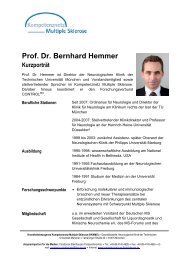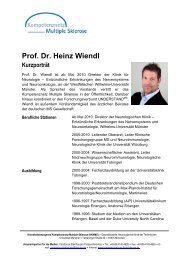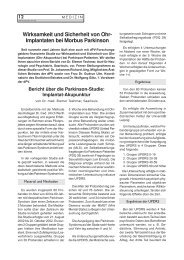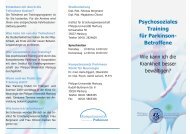Pathophysiology of Migraine - Kompetenznetz Parkinson
Pathophysiology of Migraine - Kompetenznetz Parkinson
Pathophysiology of Migraine - Kompetenznetz Parkinson
You also want an ePaper? Increase the reach of your titles
YUMPU automatically turns print PDFs into web optimized ePapers that Google loves.
124 SEMINARS IN NEUROLOGY/VOLUME 30, NUMBER 2 2010<br />
technique that is not susceptible to the artifact <strong>of</strong> Compton’s<br />
scatter were consistent with the 133 Xe blood flow<br />
studies <strong>of</strong> Olesen.<br />
BOLD imaging, based on known increases in<br />
magnetic resonance imaging (MRI) signal intensity<br />
with decreases in local deoxyhemoglobin concentration,<br />
61 was also applied to migraine aura. In one series, 62<br />
BOLD imaging was used to study occipital cortex<br />
activation patterns induced by visual stimulation in<br />
migraine with and without aura. In five <strong>of</strong> 12 subjects,<br />
headache or visual changes (but not classical aura) was<br />
preceded by areas <strong>of</strong> signal suppression that followed<br />
initial activation, which spread across the occipital lobe<br />
at a slow rate (3 to 6 mm per minute). In a later series by<br />
the same group studying migraine attacks (with and<br />
without aura) triggered by visual stimuli, 75% were<br />
found to have increases in BOLD signal within the red<br />
nucleus and substantia nigra prior to changes seen in<br />
occipital cortex, implicating these structures in both<br />
migraine with and without aura. 63<br />
In another report, BOLD imaging performed<br />
during both spontaneous (n ¼ 2) and exercise-induced<br />
visual auras 64 revealed a loss <strong>of</strong> cortical activation to<br />
visual stimuli in the occipital lobe contralateral (but not<br />
ipsilateral) to the symptomatic visual field in all patients.<br />
Activation within the affected occipital lobe returned to<br />
normal with resolution <strong>of</strong> the clinical symptoms. In the<br />
inducible subject, BOLD imaging was started after<br />
exercise but before the onset <strong>of</strong> visual symptoms. It<br />
was continued for the full duration <strong>of</strong> visual symptoms<br />
and into the headache phase after resolution <strong>of</strong> visual<br />
symptoms. When the patient reported the beginning <strong>of</strong><br />
the aura, suppression <strong>of</strong> activation was observed first in<br />
area V3a and then expanded into the neighboring<br />
occipital cortex at a rate <strong>of</strong> 3.5 mm per minute to involve<br />
both primary visual and association areas. The area <strong>of</strong><br />
BOLD signal change within striate cortex corresponded<br />
to the retinotopic visual disturbance. At the end <strong>of</strong> the<br />
studied auras, perfusion defects were present in the same<br />
areas that had exhibited abnormal BOLD activation.<br />
The BOLD MRI findings shared several characteristics<br />
with those seen in CSD, suggesting that a human<br />
analogue <strong>of</strong> CSD might be the source <strong>of</strong> migraine visual<br />
aura. The fMRI similarities include (1) CSD and the<br />
migraine visual aura are both characterized by an initial<br />
hyperemic phase lasting 3 to 4.5 minutes; (2) the<br />
hyperemia in both CSD and migraine aura is followed<br />
by mild hypoperfusion lasting 1 to 2 hours; (3) the<br />
hyperemia/hypoperfusion signal spreads across the cortex<br />
at a slow rate (2 to 5 mm/min); (4) the BOLD signal<br />
complex during both aura and induced CSD in animals<br />
halt at major sulci; (5) evoked visual responses during<br />
CSD and during aura are suppressed and take 15<br />
minutes to recover; and (6) in CSD and migraine aura,<br />
the first affected area is the first to recover normal evoked<br />
responses. Other recent investigations have shown that<br />
CSD-like phenomena, such as intercellular calcium<br />
waves propagated in astrocytes, can modulate both<br />
neuronal and vessel function 65–67 and suggest a possible<br />
role for such phenomena in human migraine aura.<br />
ALTERED CORTICAL FUNCTION IN MIGRAINE WITH AURA<br />
If the migraine visual aura arises from an increased<br />
susceptibility to induction <strong>of</strong> CSD or a CSD-like<br />
phenomenon, then underlying differences in cortical<br />
reactivity or irritability should probably be detectable.<br />
There is increasing evidence suggesting that differences<br />
between the cortices <strong>of</strong> nonmigraine sufferers and patients<br />
with migraine with aura do, in fact, exist.<br />
In the 1980s, Welch and colleagues 68,69 using 31 P<br />
magnetic resonance spectroscopy (MRS) reported a<br />
decrease in the phosphocreatinine/inorganic phosphate<br />
ratio (an index <strong>of</strong> brain phosphorylation potential) during<br />
headache in migraine patients who had aura, but not<br />
in normal controls or migraine sufferers without aura.<br />
This altered ratio was present in the context <strong>of</strong> normal<br />
pH, suggesting that the altered cortical function was<br />
caused by defective aerobic metabolism rather than vasospasm<br />
with ischemia. In another series, low levels <strong>of</strong><br />
brain magnesium were present in migraine sufferers 70<br />
possibly augmenting N-methyl-D-aspartate (NMDA)<br />
receptor activity and thereby lowering the threshold for<br />
CSD. 71 Thus far, spectroscopy has not been performed<br />
during typical migraine aura. Evoked potential studies<br />
employing several different modalities have indicated<br />
that a lack <strong>of</strong> habituation is the most reproducible<br />
interictal abnormality in the sensory processing <strong>of</strong> migraine<br />
sufferers. Evidence <strong>of</strong> altered cortical excitability<br />
in migraine aura comes from transcranial magnetic<br />
stimulation-based studies. A blinded study found a<br />
significantly lowered threshold for phosphene (visual<br />
sensation in the absence <strong>of</strong> light) generation in the<br />
occipital cortices <strong>of</strong> migraine sufferers with aura<br />
(42.8%) compared with normal controls (57.3%)<br />
[p ¼ 0.0001]. 72 However, other investigators have found<br />
reduced cortical excitability in migraine sufferers. 73<br />
Some have suggested that an instability <strong>of</strong> regulation<br />
<strong>of</strong> cortical function rather than absolute gain or loss <strong>of</strong><br />
function may underlie the propensity to migraine aura. 74<br />
Although the details <strong>of</strong> the differences in cortical function<br />
in migraine sufferers are, thus far, not completely<br />
understood, the body <strong>of</strong> evidence for the existence <strong>of</strong><br />
altered cortical function is growing. It is likely that<br />
differences in cortical processing are involved in the<br />
generation <strong>of</strong> the aura.<br />
Investigations <strong>of</strong> Headache Activation<br />
and Evolution<br />
The central feature <strong>of</strong> the migraine syndrome is headache;<br />
that is, the recurrent activation <strong>of</strong> the trigeminocervical<br />
pain system. In the physiologic setting, this<br />
Downloaded by: Universitätsbibliothek Marburg. Copyrighted material.





